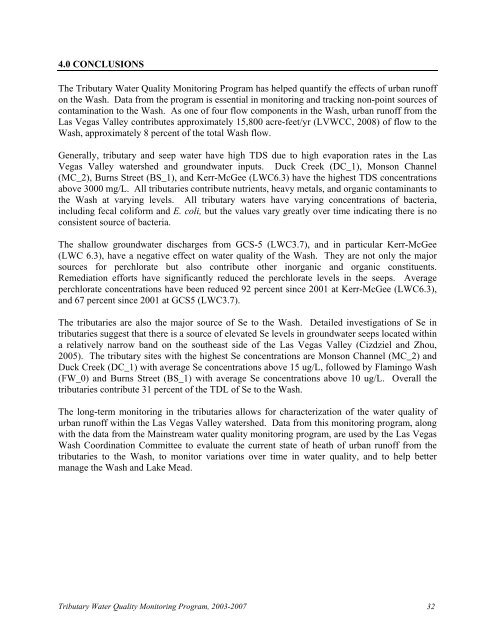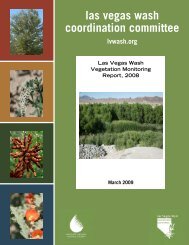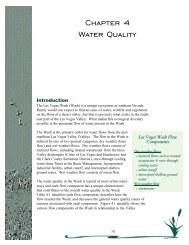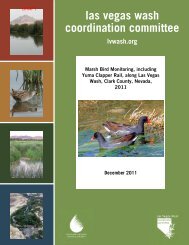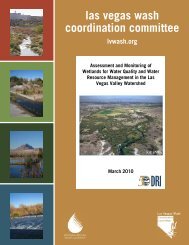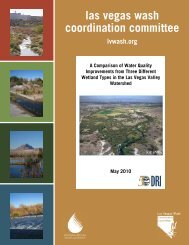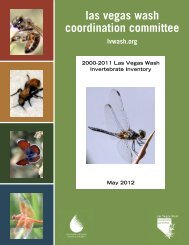Las Vegas Wash Tributaries Water Quality Report, 2003-2007
Las Vegas Wash Tributaries Water Quality Report, 2003-2007
Las Vegas Wash Tributaries Water Quality Report, 2003-2007
- No tags were found...
You also want an ePaper? Increase the reach of your titles
YUMPU automatically turns print PDFs into web optimized ePapers that Google loves.
4.0 CONCLUSIONSThe Tributary <strong>Water</strong> <strong>Quality</strong> Monitoring Program has helped quantify the effects of urban runoffon the <strong>Wash</strong>. Data from the program is essential in monitoring and tracking non-point sources ofcontamination to the <strong>Wash</strong>. As one of four flow components in the <strong>Wash</strong>, urban runoff from the<strong>Las</strong> <strong>Vegas</strong> Valley contributes approximately 15,800 acre-feet/yr (LVWCC, 2008) of flow to the<strong>Wash</strong>, approximately 8 percent of the total <strong>Wash</strong> flow.Generally, tributary and seep water have high TDS due to high evaporation rates in the <strong>Las</strong><strong>Vegas</strong> Valley watershed and groundwater inputs. Duck Creek (DC_1), Monson Channel(MC_2), Burns Street (BS_1), and Kerr-McGee (LWC6.3) have the highest TDS concentrationsabove 3000 mg/L. All tributaries contribute nutrients, heavy metals, and organic contaminants tothe <strong>Wash</strong> at varying levels. All tributary waters have varying concentrations of bacteria,including fecal coliform and E. coli, but the values vary greatly over time indicating there is noconsistent source of bacteria.The shallow groundwater discharges from GCS-5 (LWC3.7), and in particular Kerr-McGee(LWC 6.3), have a negative effect on water quality of the <strong>Wash</strong>. They are not only the majorsources for perchlorate but also contribute other inorganic and organic constituents.Remediation efforts have significantly reduced the perchlorate levels in the seeps. Averageperchlorate concentrations have been reduced 92 percent since 2001 at Kerr-McGee (LWC6.3),and 67 percent since 2001 at GCS5 (LWC3.7).The tributaries are also the major source of Se to the <strong>Wash</strong>. Detailed investigations of Se intributaries suggest that there is a source of elevated Se levels in groundwater seeps located withina relatively narrow band on the southeast side of the <strong>Las</strong> <strong>Vegas</strong> Valley (Cizdziel and Zhou,2005). The tributary sites with the highest Se concentrations are Monson Channel (MC_2) andDuck Creek (DC_1) with average Se concentrations above 15 ug/L, followed by Flamingo <strong>Wash</strong>(FW_0) and Burns Street (BS_1) with average Se concentrations above 10 ug/L. Overall thetributaries contribute 31 percent of the TDL of Se to the <strong>Wash</strong>.The long-term monitoring in the tributaries allows for characterization of the water quality ofurban runoff within the <strong>Las</strong> <strong>Vegas</strong> Valley watershed. Data from this monitoring program, alongwith the data from the Mainstream water quality monitoring program, are used by the <strong>Las</strong> <strong>Vegas</strong><strong>Wash</strong> Coordination Committee to evaluate the current state of heath of urban runoff from thetributaries to the <strong>Wash</strong>, to monitor variations over time in water quality, and to help bettermanage the <strong>Wash</strong> and Lake Mead.Tributary <strong>Water</strong> <strong>Quality</strong> Monitoring Program, <strong>2003</strong>-<strong>2007</strong> 32


